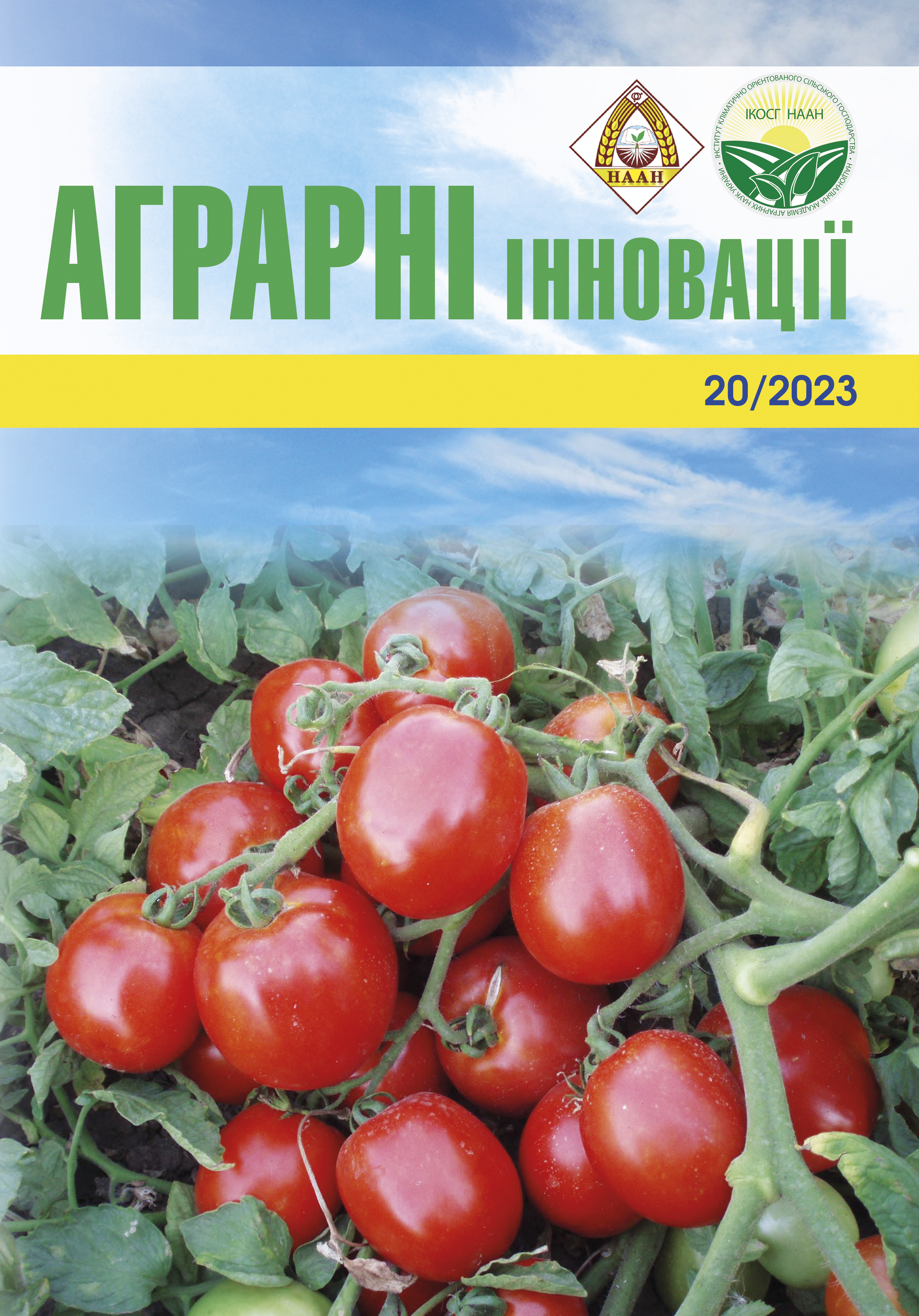Mutagenic depression in winter wheat under the action of highly active supermutagens
Abstract
The use of chemical supermutagens makes it possible to significantly speed up the process of genetic improvement of existing original forms, but runs into the problem of the phenomenon of mutagenic depression. Purpose. The aim of the research was to reveal the features of the genotypemutagenic interaction of two contrasting genotypes of winter wheat under the action of chemical supermutagens with high damaging activity in the generally accepted range of concentrations for genetic improvement. Methods.The seeds of two varieties of winter wheat, Altigo and Spivanka, were treated with an aqueous solution of the chemical mutagens sodium azide in concentrations of 0.01%, 0.025%, 0.05%, 0.1% and ethyl methanesulfonate (hereinafter EMS) in concentrations of 0.025%, 0.05%, 0.1%. 1000 grains of winter wheat were used for each treatment. Exposure to the mutagen was 24 hours. Unprocessed initial forms (grains of varieties soaked in water) were used for control. Pollen sterility was determined by light microscopy of acetocarmine-stained samples (20–25 preparations). Structural analysis of plants was carried out. Results. According to the indicators of ontogenesis, the Spivanka variety was much more resistant to depressive influences in the first generation than the French variety. In turn, as a mutagen, sodium azide showed its effect in general more strongly at similar concentrations than EMS. The range of applied concentrations reached semi-lethal values. As a result of the factor analysis, a significant influence of the genotype (variety) and an increase in the concentration of mutagens was revealed in all cases. The difference in overwintering is also quite reliable. In all cases, for all varieties, sterility increased statistically significantly under the influence of all concentrations. The genotypic variance was reliable at higher concentrations in favor of a stronger effect of sodium azide. Significant mutagen depression at each increased concentration was shown by the parameters of stem height, grain weight from the head, grain size of the plant, and weight of a thousand grains. The difference between the genotypes is not for all concentrations, but in general it is significant. No cases of stimulation were recorded. Discriminant analysis showed that germination, survival, fertility, grain weight from the main spike and from the plant, TGW, were highly variable, reliably reproducing mutagenic depression. Findings. Sodium azide causes a significantly higher level of mutagenic depression than ethyl methanesulfonate, and the variety Altigo is more vulnerable than the variety Spivanka in terms of its genetic potencies. The use of the third concentration of EMS and the thirdfourth sodium azide leads to the significant death of plant material, and is not desirable. The most optimal level of depression is the use of EMS in concentrations of 0.025% and 0.05% and sodium azide in concentrations of 0.01% and 0.025%. Germination, survival, fertility, grain weight from the main ear and from the plant, TGW, which are monitoring for depressive effects, have high variability at increased concentrations of mutagens.
References
2. Bilgın O., Sarier S., Başer I., & Balkan A. (2022). Enhancement of androgenesis and plant regeneration from wheat anther culture by seed pre-sowing gamma irradiation. Journal of Tekirdag Agricultural Faculty, 19(2), 354–365. doi: 10.33462/jotaf.993270
3. Ergün N., Akdoğan G., Ünver İkincikarakaya S., Aydoğan S. (2023). Determination of Optimum Gamma Ray Irradiation Doses for Hulless Barley (Hordeum vulgare var. nudum L. Hook. f.) Genotypes. Yuzuncu Yil University Journal of Agricultural Sciences, 33, 219–230. doi: https://doi.org/10.29133/yyutbd.1248710
4. Jalal A., Oliveira J., Ribeiro J., Fernandes G., Mariano G., Trindade V., Reis A.R. (2021). Hormesis in plants: Physiological and biochemical responses. Ecotoxicology and Environmental Safety, 207, 111225.
5. Gupta S., Datta A., Pramanik A., Biswas J., Karmakar R. (2019). X-ray and gamma irradiation induced chromosomal aberrations in plant species as the consequence of induced mutagenesis – an overview. Plant Archives, 19, 1973–1979.
6. Hong M., Kim D., Jo Y., Choi H.-I., Ahn J.-W., Kwon S.-J., Kim S., Seo Y., Kim J.-B. (2022). Biological Effect of Gamma Rays According to Exposure Time on Germination and Plant Growth in Wheat. Applied Sciences, 12, 3208. doi: https://doi.org/10.3390/app12063208
7. Nazarenko M. (2020). Induction of winter wheat plant structure mutations by chemomutagenesis. Agrology, 3(1), 57-65. doi: 10.32819/020008
8. OlaOlorun B., Shimelis H., Laing M., Mathew I. (2021). Development of Wheat (Triticum aestivum L.) Populations for Drought Tolerance and Improved Biomass Allocation Through Ethyl Methanesulphonate Mutagenesis. Frontiers in Agronomy, 3, 655820. doi: 10.3389/fagro.2021.
9. Shabani M., Alemzadeh A., Nakhoda B., Razi H., Houshmandpanah Z., Hildebrand D. (2022). Optimized gamma radiation produces physio-logical and morphological changes that improve seed yield in wheat. Physiology and Molecular Biology of Plants, 28(8), 1571–1586. doi: 10.1007/s12298-022-01225-0
10. Von Well E., Fossey A., Booyse M. (2022). Effect of gamma irradiation on nucleolar activity, an indicator of metabolic activity, in root tip cells of tetraploid Triticum turgidum ssp. durum L. Protoplasma, 259(2), 453-468. doi: 10.1007/s00709-021-01684-4






